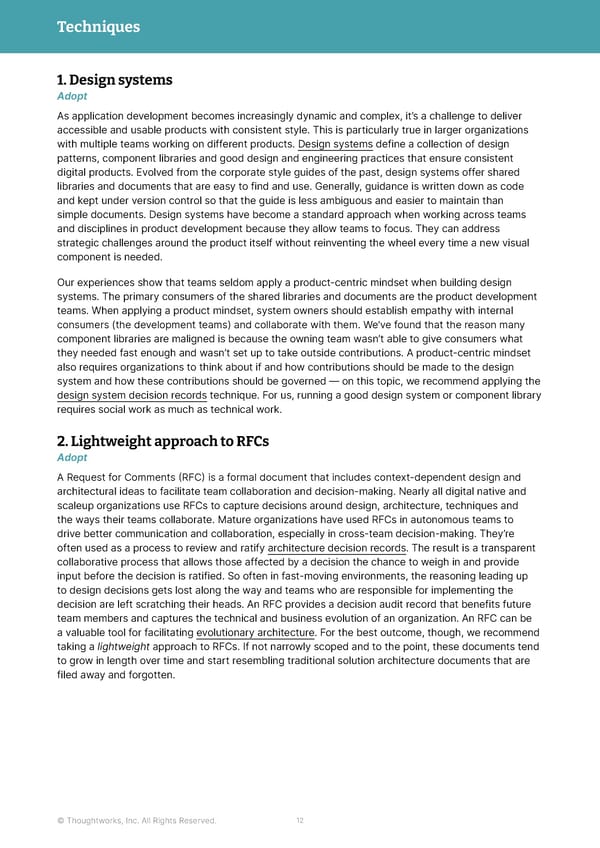Techniques 1. Design systems Adopt As application development becomes increasingly dynamic and complex, it’s a challenge to deliver accessible and usable products with consistent style. This is particularly true in larger organizations with multiple teams working on different products. Design systems define a collection of design patterns, component libraries and good design and engineering practices that ensure consistent digital products. Evolved from the corporate style guides of the past, design systems offer shared libraries and documents that are easy to find and use. Generally, guidance is written down as code and kept under version control so that the guide is less ambiguous and easier to maintain than simple documents. Design systems have become a standard approach when working across teams and disciplines in product development because they allow teams to focus. They can address strategic challenges around the product itself without reinventing the wheel every time a new visual component is needed. Our experiences show that teams seldom apply a product-centric mindset when building design systems. The primary consumers of the shared libraries and documents are the product development teams. When applying a product mindset, system owners should establish empathy with internal consumers (the development teams) and collaborate with them. We’ve found that the reason many component libraries are maligned is because the owning team wasn’t able to give consumers what they needed fast enough and wasn’t set up to take outside contributions. A product-centric mindset also requires organizations to think about if and how contributions should be made to the design system and how these contributions should be governed — on this topic, we recommend applying the design system decision records technique. For us, running a good design system or component library requires social work as much as technical work. 2. Lightweight approach to RFCs Adopt A Request for Comments (RFC) is a formal document that includes context-dependent design and architectural ideas to facilitate team collaboration and decision-making. Nearly all digital native and scaleup organizations use RFCs to capture decisions around design, architecture, techniques and the ways their teams collaborate. Mature organizations have used RFCs in autonomous teams to drive better communication and collaboration, especially in cross-team decision-making. They’re often used as a process to review and ratify architecture decision records. The result is a transparent collaborative process that allows those affected by a decision the chance to weigh in and provide input before the decision is ratified. So often in fast-moving environments, the reasoning leading up to design decisions gets lost along the way and teams who are responsible for implementing the decision are left scratching their heads. An RFC provides a decision audit record that benefits future team members and captures the technical and business evolution of an organization. An RFC can be a valuable tool for facilitating evolutionary architecture. For the best outcome, though, we recommend taking a lightweight approach to RFCs. If not narrowly scoped and to the point, these documents tend to grow in length over time and start resembling traditional solution architecture documents that are filed away and forgotten. © Thoughtworks, Inc. All Rights Reserved. 12
 Thoughtworks Technology Radar Page 11 Page 13
Thoughtworks Technology Radar Page 11 Page 13